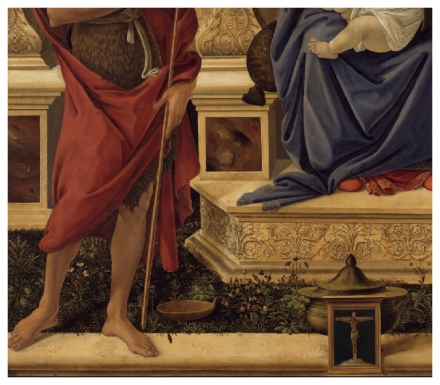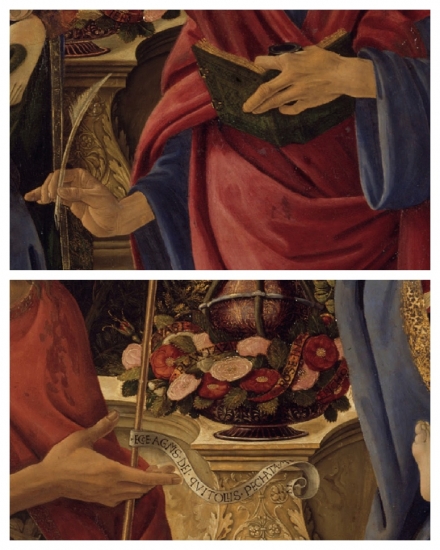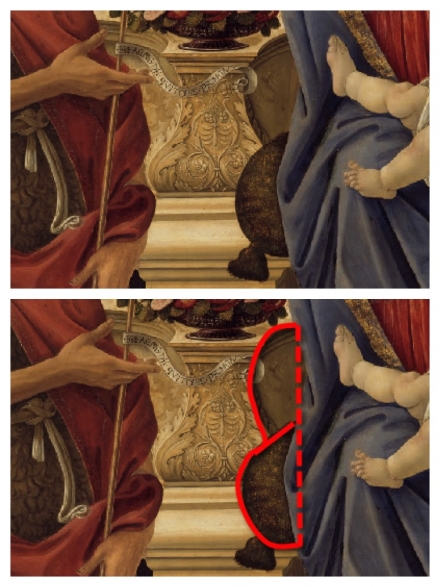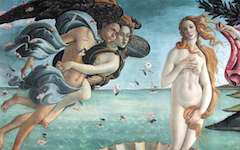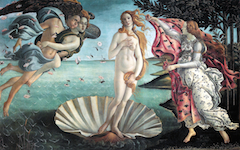Botticelli’s Virgin and Child with Saints…(1484-5)
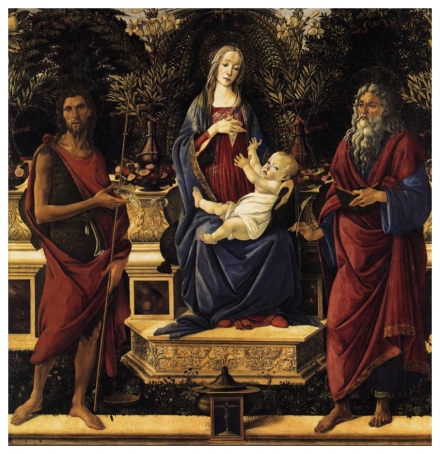
Botticelli, Virgin and Child with Saints John the Baptist and John the Evangelist (1484-5) Tempera on panel. Gemäldegalerie, Berlin.
Click image to enlarge.
In a painting by Botticelli designed to to grace the altar of a chapel two saints, John the Baptist and John the Evangelist, stand on either side of an enthroned Virgin holding the Christ Child. Not all is quite as simple as it may seem though.
Click next thumbnail to continue
The saints, for instance, do not stand with the Virgin within the scene bursting with vegetation but outside on a ledge on which a small framed painting of art's iconic subject, the Crucifixion, also sits. Thus the scene behind them looks like a wall painting, a flat, upright picture in front of which the two saints stand as though they were "artists" in a studio which is what they are.
Click next thumbnail to continue
The Evangelist (top), whom you might think holds a pen to identify himself as a writer, actually handles it like a painter's brush. It looks as if he has just dipped it in the inkpot in his other hand not to write in the book, which is behind his quill, but to paint or draw something in front of us.
Likewise, the Baptist (bottom) holds his hand with his thumb separated as though holding a palette. This is a little-known but very common symbol in painting for a palette-hand.1 Above it to the right is a vase of roses, a symbol for the Virgin but for a palette too.
Click next thumbnail to continue
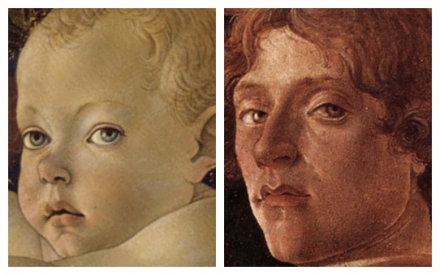
L: Detail of Botticelli's Virgin and Child with Saints...
R: Self-portrait detail from Botticelli's Adoration of the Magi (1475)
Click image to enlarge.
The two saints have "painted" the Virgin and Child which, according to the paradigm proposed on this site, must also be the "artist". And so Christ is. He has an infantile version of Botticelli's features including light, curly hair, a nose with a sharp-ish tip and an accentuated curve to the nostril aching to grow larger. Christ's mouth shares the artist's undulating lips and a central dent in the chin.
Click next thumbnail to continue
Besides Botticelli formed the two cushions behind the Virgin into the shape of an inverted B for his name. Note, though, how the cushions also resemble breasts with the white banner simulating milk flowing from a "nipple" which is itself suggested by the tight curlicue at the banner's end.
See also (in a prior frame) the two vases on either side of the Virgin, one of which is above the "palette" of roses. They seem to resemble the alembics which alchemists used in their laboratories to purify essences. Encased in metal tubing, they also recall the shape of eyeballs with their optical nerves directed upwards to the brain. [See Picasso's Eyeball and the contemporaneous St. John in the Wilderness by Heironymous Bosch] The vegetation growing out of the vases and across the background symbolizes the artist's fertile imagination growing in every direction, nature as input to the eyes and all our senses.
See conclusion below
As in so many masterpieces including Michelangelo's Vatican Pietá [see entry] the Virgin's womb symbolizes the artist's mind, both of which have had an Immaculate Conception. In so doing the artist, in becoming at one with God, has metaphorically been re-born as Christ. That is why the infant so prominently displays the two hands of the artist and the symbols of his craft. The Virgin's hand over her breast touches herself as though "painting" herself. Her other hand, behind Christ, echoes the Baptist's palette-hand with its separated thumb. It thereby suggests that the infant Christ (or Christ-as-Botticelli) is the palette from which all his art is created, the archetypal pattern from which his images are formed. His compositions are visual metamorphoses of the divine essence inside his mind, that essential element inside every human mind if we could but see it, our own divinity or inner wisdom.
For those new to the site, please see the theme The Inner Tradition for further explanation of the prior statement.
More Works by Botticelli
Learn how to note passages between one level of reality and another
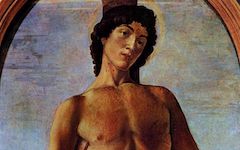
Botticelli’s St. Sebastian (c.1473)
Notes:
1. The earliest palette-hand described on the site is from the first half of the fourteenth century. Examples include but are not limited to: Simone Martini’s St. Luke (c.1330’s) and other saints; Ferdinand Bol’s Portrait of a Man Holding a White Plume (1648); Courbet’s Woman in a Riding Habit (1856); Degas’ Edouard Manet at the Races (c.1865) and Manet’s Skating (1877)
2. I have already shown how in the nineteenth century Manet's African maid in Olympia (1863) holds a bouquet of flowers in place of a palette which Picasso then turned into a bowl of fruit with a palette-hole in it in his so-called Parody of Manet's Olympia (c.1901-3). Both artists seem to have been aware of how often flowers symbolize an artist's palette and colors. Other examples on the site include Odilon Redon’s Pavots et Oeillets de Poète… (c.1906) and Bonnard’s The Green Blouse (1919). Their full story remains to be told but I will add new examples as soon as I can.
Original Publication Date on EPPH: 02 Aug 2013. © Simon Abrahams. Articles on this site are the copyright of Simon Abrahams. To use copyrighted material in print or other media for purposes beyond 'fair use', you must obtain permission from the copyright owner. Websites may link to this page without permission (please do) but may not reproduce the material on their own site without crediting Simon Abrahams and EPPH.
